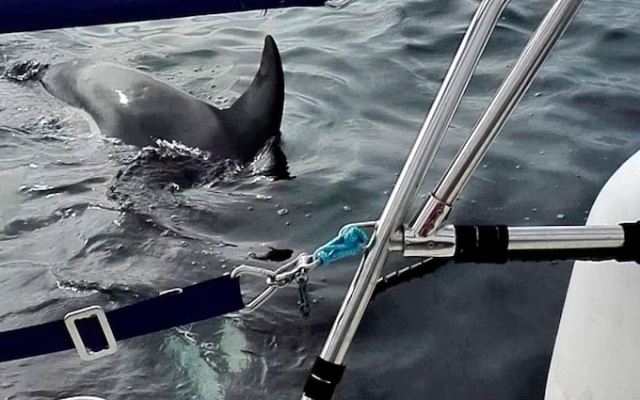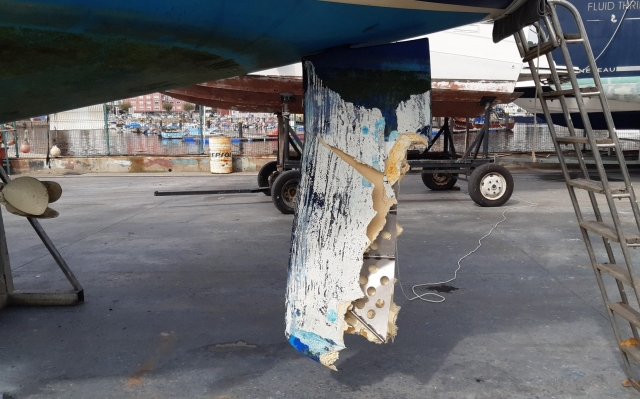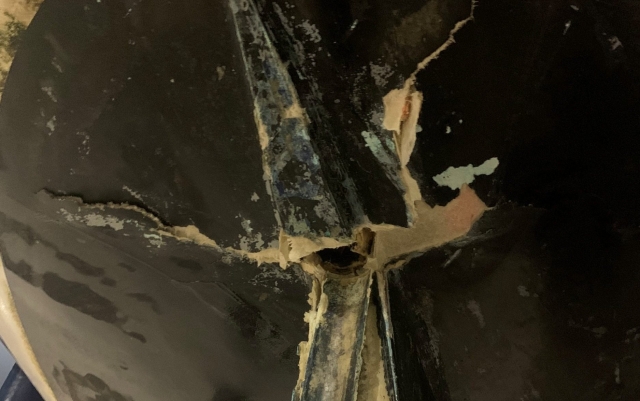 The killer whale known as White Gladys is believed to have trained her fellow killer whales to attack passing ships.
The killer whale known as White Gladys is believed to have trained her fellow killer whales to attack passing ships.
British sailors have been ordered to carry sandbags on their yachts to protect themselves from killer whales responsible for hundreds of attacks on boats in the Strait of Gibraltar.
More than 250 yachts were damaged and three sunk as attacks in the strait and off the coast of Spain and Portugal were first reported in 2020.
A female killer whale named White Gladys, possibly injured after being hit by a boat, is believed to have trained her fellow whales to attack passing ships.
Fifteen killer whales from the region's killer whale population of 35 are responsible for ram raids, in which apex predators typically slam their heads against the rudder of a boat until it breaks.
 More than 250 yachts were damaged, three of them were sunk by killer whales. Photo: Ivkovich/iStockphoto
More than 250 yachts were damaged, three of them were sunk by killer whales. Photo: Ivkovich/iStockphoto
But throwing sand into the water around the rudder knocks down the killer whale's sonar and can keep the boat moving during the attack. , — said the Cruise Association.
“Sand should not be much. A few kilos,” said John Burbeck, Project Team Leader Orca at the Cruiser Association.
“Orcas are detected using sonar, not vision. We know it. And the sand around the rudder confuses the image they capture,” he said.
One skipper reported success with the sand method, which requires five to eight kilograms of material and creates “acoustic noise.” mirror effect”, in April of this year.
The trick, according to the Cruise Association, is to hide the rudder behind a screen of sand in preparation for reverse.
Mr Burbeck said the deterrent works best when paired with the crew's rattling pots and frying pans. deck to prompt the pod to stop its attacks, which can last for over an hour.
 Damage to a boat by a killer whale known as White Gladys off the coast of Gibraltar. Photo: Grupo de trabajo Orca Atlántica
Damage to a boat by a killer whale known as White Gladys off the coast of Gibraltar. Photo: Grupo de trabajo Orca Atlántica
Research continues on whether racing in shallow water is a good tactic because killer whales prefer to be in areas where tuna, their main prey, is usually found.
So far, no one has seriously suffered during an attack by highly intelligent animals that can travel up to 100 miles a day.
Some researchers believe that the learned behavior is related to the game, but others see the attacks as more predatory or even revenge for White Gladys' injury.
“What worries us is the time when the killer whale hits with such force that someone topples in the cockpit and breaks his skull. The whole dynamic of our relationship with this endangered population will change,” Mr Burbeck said.
The Cruise Association collects data and reports on killer whale attacks by working closely with Portuguese and Spanish marine biologists. There are apps and social media accounts that help skippers report interactions and alert other sailors that aggressive killer whales may be around.
Thousands of boats can be found in the Strait of Gibraltar during the summer season when the number of sightings usually increases with killer whales.
Boats sink because the whales hit the rudder with such force that it splits the hull. .
There have been 26 interactions since the beginning of this year, with one boat sinking in addition to the two that sank last year.
 A sailboat damaged by killer whales off the coast of southern Spain. Photo: April Boyes/April Boyes via REUTERS. as far north as Brest in France last year. There were 11 killer whale attacks in May alone.
A sailboat damaged by killer whales off the coast of southern Spain. Photo: April Boyes/April Boyes via REUTERS. as far north as Brest in France last year. There were 11 killer whale attacks in May alone.
On Thursday, killer whales severely damaged a sailboat off the coast of southern Spain and forced a four-man crew to call for help.
Orcas broke the rudder of the Mustique, which was sailing under the British flag and pierced its hull.
Spanish authorities deployed a rapid reaction boat and a helicopter with a bilge pump and towed the 66-foot vessel to the port of Barbate. in Cadiz for repairs.
“An experience I will never forget,” Stephen Bidwell, 58, said of a separate attack by six killer whales on his boat on May 2.
«I kept reminding myself that we have a 22-ton steel boat, but seeing three of them approach at the same time, quickly and at a pace with fins out of the water, was intimidating,» said the Cambridge photographer.< /p >




















































Свежие комментарии